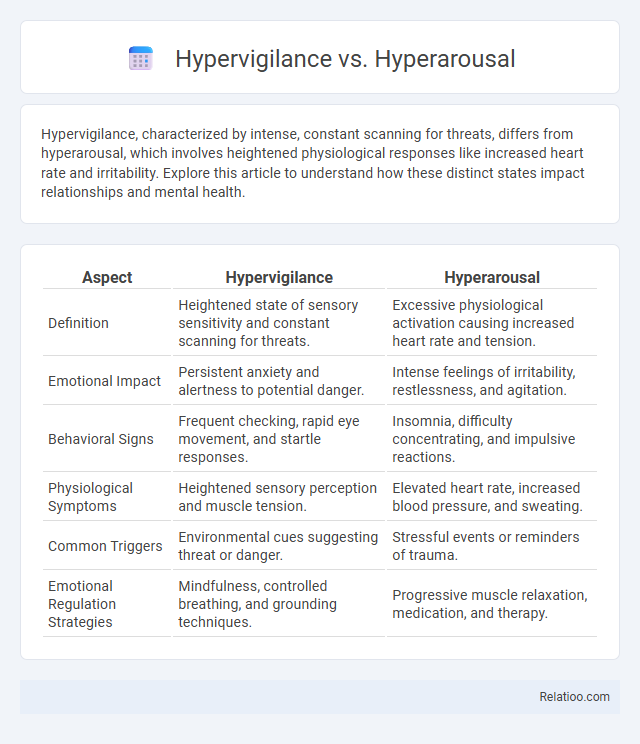Hypervigilance, characterized by intense, constant scanning for threats, differs from hyperarousal, which involves heightened physiological responses like increased heart rate and irritability. Explore this article to understand how these distinct states impact relationships and mental health.
Table of Comparison
| Aspect | Hypervigilance | Hyperarousal |
|---|---|---|
| Definition | Heightened state of sensory sensitivity and constant scanning for threats. | Excessive physiological activation causing increased heart rate and tension. |
| Emotional Impact | Persistent anxiety and alertness to potential danger. | Intense feelings of irritability, restlessness, and agitation. |
| Behavioral Signs | Frequent checking, rapid eye movement, and startle responses. | Insomnia, difficulty concentrating, and impulsive reactions. |
| Physiological Symptoms | Heightened sensory perception and muscle tension. | Elevated heart rate, increased blood pressure, and sweating. |
| Common Triggers | Environmental cues suggesting threat or danger. | Stressful events or reminders of trauma. |
| Emotional Regulation Strategies | Mindfulness, controlled breathing, and grounding techniques. | Progressive muscle relaxation, medication, and therapy. |
Understanding Hypervigilance: Definition and Key Features
Hypervigilance is an enhanced state of sensory sensitivity accompanied by an intense focus on detecting potential threats, often linked to anxiety and PTSD. Unlike hyperarousal, which involves heightened physiological responses such as increased heart rate and irritability, hypervigilance centers on persistent alertness and scanning the environment for danger. Understanding these distinctions helps you recognize key features like constant awareness, difficulty relaxing, and exaggerated startle responses essential for accurate diagnosis and treatment.
What Is Hyperarousal? A Clinical Overview
Hyperarousal is a state characterized by heightened sensory sensitivity, increased heart rate, and an exaggerated startle response, often linked to stress and trauma-related conditions like PTSD. You may experience difficulty sleeping, irritability, and constant feelings of being on edge as your nervous system remains in a persistent "fight or flight" mode. Clinically, hyperarousal differs from hypervigilance, which involves excessive attention to potential threats, and understanding these distinctions is crucial for effective diagnosis and treatment.
Hypervigilance vs Hyperarousal: Main Differences
Hypervigilance involves an intense state of alertness where Your brain constantly scans the environment for threats, often linked to anxiety and trauma disorders. Hyperarousal, on the other hand, is characterized by heightened physiological activation such as increased heart rate, irritability, and difficulty sleeping, commonly seen in PTSD and stress responses. The key difference lies in hypervigilance's cognitive focus on threat detection, whereas hyperarousal pertains more to the body's amplified physical reaction.
Causes and Triggers of Hypervigilance
Hypervigilance is a state of heightened sensory sensitivity and constant scanning for threats, often triggered by trauma, anxiety disorders, or chronic stress, causing your brain to remain on high alert. Unlike hyperarousal, which involves increased physiological responses like rapid heartbeat and agitation, hypervigilance focuses more on the persistent mental alertness and environmental monitoring. Hypervigilance's causes include traumatic experiences such as PTSD, ongoing fear, or perceived danger, which condition your nervous system to anticipate threats continuously.
Common Causes of Hyperarousal
Hyperarousal, commonly caused by chronic stress, trauma, and anxiety disorders, manifests as heightened sensory sensitivity and increased alertness. Unlike hypervigilance, which involves excessive scanning for threats, and hyperactivity, characterized by excessive physical movement, hyperarousal primarily affects the autonomic nervous system, leading to sleep disturbances and irritability. Understanding the common causes such as post-traumatic stress disorder (PTSD) and panic disorders is crucial for targeted interventions.
Symptoms: How Hypervigilance and Hyperarousal Manifest
Hypervigilance presents as an excessive state of sensory sensitivity accompanied by an exaggerated intensity of behaviors aimed at detecting threats, often leading to constant scanning of the environment and heightened startle responses. Hyperarousal is characterized by persistent physiological and psychological tension, manifesting as irritability, difficulty sleeping, and an exaggerated fight-or-flight response. Your ability to distinguish between these symptoms is crucial for accurate assessment and effective management of stress-related disorders.
Impact on Daily Life: Functioning and Relationships
Hypervigilance causes constant scanning of the environment for threats, impairing Your focus and increasing stress, which negatively affects daily functioning and social interactions. Hyperarousal involves heightened physiological activation, leading to sleep disturbances, irritability, and difficulty concentrating, disrupting work performance and emotional regulation in relationships. Both conditions contribute to chronic anxiety, but hypervigilance specifically hinders trust and communication, while hyperarousal primarily impacts physical well-being and energy levels.
Assessment and Diagnosis: Tools and Approaches
Assessment and diagnosis of hypervigilance, hyperarousal, and hypervigilance rely on clinical interviews, standardized scales, and physiological measurements to distinguish these overlapping yet distinct symptoms. Tools such as the Clinician-Administered PTSD Scale (CAPS) assess hyperarousal by evaluating sleep disturbances, irritability, and startle responses, while the Hypervigilance Questionnaire targets persistent environmental scanning and threat detection behaviors. Neurobiological assessments, including heart rate variability and skin conductance monitoring, provide objective data to differentiate hyperarousal from hypervigilance, supporting personalized treatment planning.
Treatment Strategies: Managing Hypervigilance and Hyperarousal
Treatment strategies for managing hypervigilance and hyperarousal primarily include cognitive-behavioral therapy (CBT) to reframe negative thought patterns and exposure therapy to gradually reduce sensitivity to triggers. Pharmacological interventions such as selective serotonin reuptake inhibitors (SSRIs) and benzodiazepines may be prescribed to control anxiety symptoms and improve sleep quality. Mindfulness techniques and relaxation exercises are effective complementary approaches to reduce physiological arousal and enhance emotional regulation.
Coping Tips and Self-Help Techniques
Hypervigilance, hyperarousal, and hyperawareness each involve heightened states of alertness but differ in cause and experience, with hypervigilance linked to trauma, hyperarousal to anxiety, and hyperawareness to sensory sensitivity. You can manage these by practicing grounding techniques, deep breathing exercises, and progressive muscle relaxation to reduce physiological stress responses. Establishing a consistent routine, engaging in mindfulness meditation, and seeking professional support when needed are effective self-help strategies to improve emotional regulation and overall well-being.

Infographic: Hypervigilance vs Hyperarousal
 relatioo.com
relatioo.com